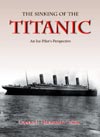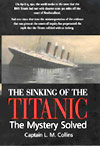|
| To Search This Site Enter Key Words Into Text Field On The Right and Hit The Search Button |
|
|
Captain L. Marmaduke Collins.
 |
Collins, Captain L. Marmaduke. The Sinking of the Titanic, An Ice Pilot’s Perspective. 1st printing. St. Johns, Newfoundland: Breakwater Books. April, 2002. wraps. isbn: 1550811738. scarcity: fairly common.
The primary purpose of this book is to propose a radical new theory about the Titanic collision, that the ship smashed not into a berg, but rather into low lying pack ice. In actuality though, only about half the book is devoted to this subject. There are additional chapters on several wide-ranging topics, including a look at Captain Smith’s navigation, the case of the Californian, and fourth officer Boxhall’s famous wreck position coordinates.
The first subject, that the ship never hit an iceberg at all, but rather pack ice, is a daring theory. Before you scoff too much, take a look at the author’s credentials. Collins is one of the very few authors to write on this subject who has had personal experience dealing with icebergs. He is a retired master mariner, with over four decades of experience navigating vessels on the North Atlantic, which included many years of work as an ice pilot in the Newfoundland and Labrador Harbour, Coastal and Ice Pilotage Service.
In roughly 20 pages Collins develops the arguments for this theory. The writing style is straight forward, and the information is related in a logical progression. One clever touch is an interesting analogy of how a ship handles by comparing it to attempting to steer a bus in reverse. Some of the author’s evidence is tempting, such as lookout Frederick Fleet’s initial descriptions of what lie ahead, comparing what he saw to two tables pushed together. Other parts I had more of a problem with, such as asking me to believe that quartermaster Rowe mistook a six foot high ice field for an 100 foot tall berg at close proximity while it drifted past the starboard side of the ship.
Following that chapter is an additional 65 pages of supportive testimony culled from the American and British inquiries as well as passenger eyewitness accounts. This testimony is annotated by the author, but only sporadically. I would have liked to see the author jump in more often with his thoughts and insights. You will have to judge for yourself whether the author succeeds in making his case. I remain skeptical. The theory makes for intriguing reading, yet I felt it was not developed enough.
The next chapter contains a brief look at Captain Smith’s navigation during the maiden voyage. It has always seemed illogical to me that Smith was as nonchalant in his attitude to the dangers of ice ahead of the ship as history seems to want us to believe. Collins does a very credible job of explaining that, quite the opposite, Smith reacted with sound judgment to the information that was at his disposal to navigate the ship in a safe and responsible manner.
The next substantial section of the book looks at the case of the Californian, and whether this vessel was the infamous “mystery ship” that watched the disaster unfold, but never came to help. The author’s experience really comes to the fore in this section, and he explains in a very clear and concise manner why the Californian could not have been close enough to be seen by those on Titanic. His own research has unearthed a brand new possibility for the identity of the mystery vessel. There follows another chapter that again includes excerpts of testimony from the inquiries on this subject.
Finally there is something of a bombshell theory wrapping up this volume. The author believes that fourth officer Boxhall’s CQD position was not, I repeat, not wrong. The fact that the wreck was found some 13 miles east of Boxhall’s coordinates and somewhat south of them requires a powerful argument indeed to be taken seriously. Collins proposes that after Titanic sank (intact by the way) it possibly turned turtle, capturing air in some compartments which kept it buoyant, slowly settling towards the bottom and drifting east at the same time. I am obviously simplifying Collins’ explanations, but that is the gist of the argument.
He then suggests that years after impacting on the bottom, the well documented undersea earthquake of 1929 shoved the wreck even further east, breaking it in two in the process. Collins’ supporting arguments, unfortunately, are weaker here than in any other part of the book. The evidence given does not in any way support such a radical theory.
As a whole, the author certainly has developed some fascinating concepts. I would have liked to see his arguments more fully developed, particularly in the pack ice and Boxhall CQD position chapters. Still, if the technical aspects of the disaster fascinate you, the theories are intriguing enough to make this book worth your time.
For more information, see the description on the publisher's website, Breakwater Books.
|
 |
Collins, Captain L. Marmaduke. The Sinking of the Titanic, the Mystery Solved. 1st British printing. London: Souvenir Press, Ltd. October, 2004. hardcover. isbn: 0285637118. scarcity: fairly common.
The Sinking of the Titanic the Mystery Solved is an expanded edition of Collin’s book The Sinking of the Titanic, an Ice Pilot’s Perspective, originally published in 2002. According to the publisher, there are changes and additions to the text which amount to about 10% of the total book. There are also four photographic plates in the Souvenir Press edition that are not found in the first edition.
|
|
|
|
|